|
Winmate Rugged Tablet PC V280
Flexible and highly configurable fanless slate computer platform for tough jobs
(by Conrad H. Blickenstorfer -- view PDF version)
Winmate is a Taiwanese company founded in 1994. Specializing in industrial display technologies and solutions, Winmate also branched out into Panel PCs, digital signage, marine grade displays and computers and, most recently, rugged Mobile PCs, panels, embedded automation controllers, and rugged Tablet PCs as the V280 reviewed in this article. Winmate does not have the name recognition of some of the major players in the rugged field, but that is often the case with Taiwanese OEMs who either make products for name brands or quietly distribute through resellers.
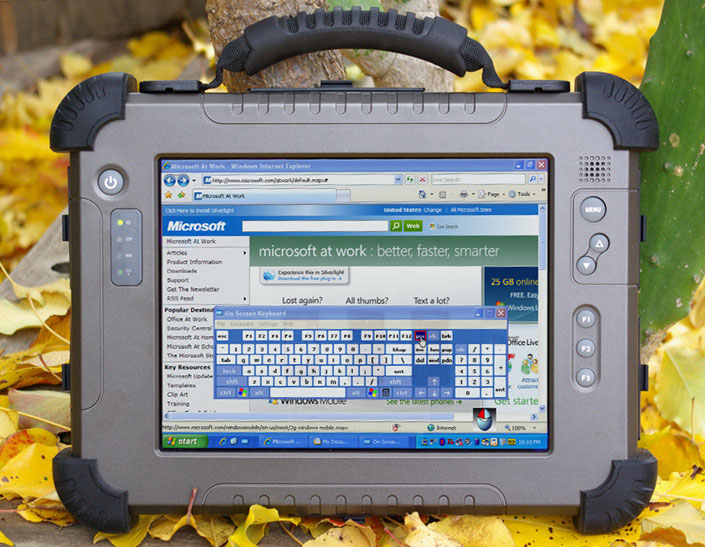
The V280 is a rugged Tablet PC slate family that comes in a variety of configurations. This review covers the R10V28M-RTU1A model that comes with a 10.4-inch SVGA (800 x 600 pixel) display with a 4-wire resistive touchscreen. The standard display has a reasonably strong 220 nits backlight (commercial notebooks usually have less than 200 nits), and a sunlight-viewable display with a more powerful backlight (over 500 nits) is optionally available. Onboard connectivity consists of three USB 2.0 ports, a RS232 connector, video, a gigabit Ethernet RJ45 jack, microphone and headphone jacks, and a docking connector. The dock features four more USB ports as well as another RS232 port.
The machine measures 12.25 x 9.1 inches and weighs a bit over six pounds as tested. Our test unit was powered by a 1.2GHz VIA C7M Nano processor that was designed from the start to deliver the highest x86 performance per watt, and uses the complementary VIA VX700 chipset. The V280 uses either half a gigabyte or a gigabyte of DDR2 400 memory in a SO-DIMM. Storage is either via a high performance 80GB 2.5-inch hard disk, a solid state disk, or industrial CF Card-based Flash. The machine has integrated 802.11b/g WiFi and Bluetooth. WWAN (GPRS/ GSM/ CDMA/ UMTS/ EDGE) and GPS are available via PC Card extensions.
As such the computer is designed for use in applications where workers carry the machine around on the job and use it while standing up, which makes a notebook impractical. The V280 is also designed to be used in situation where it might get dropped, rained on, or encounter extreme temperatures or other adverse environmental conditions. Winmate specifically targets this machine to applications in field service, law enforcement, fire/emergency, transportation and distribution, construction, utility & energy, warehousing, patient information, and retail.
Design and construction
The Winmate Tablet PC V280 sports an elegant, practical design and aluminum-magnesium alloy construction with ports that are individually sealed with protective rubber plugs. While the machine can be used without them if size is an issue, Winmate added four very thick rubber bumpers that screw onto the four corners of the slate. The bumpers are securely attached via two screws each, but they are fairly soft and sit on top of the machine as opposed to being integrated into the design. This may make them vulnerable to getting caught or accidentally ripped off. Winamte says the final production pads are harder and less prone to separation.
Below you can see all four side views of the Winmate V280. Note that the sturdy protective rubber plugs were left in place for product photography.

Winmate designed the V280 with a minimum of hardware controls and buttons in order to make it as simple as possible to operate. To the left of the display is a large power button, and to the right of it an equally large menu button with up and down buttons below it. When pushed, the menu button cycles through:
- Brightness (adjustable in eight steps)
- Volume (adjustable in eight steps)
- Remaining battery life in percent, and
- WiFi/Bluetooth (WiFi on/off, Bluetooth on/off, both on/off)
Brightness does not go down all the way to off. As listed, the radios can either both be off, both on, or either WiFi or Bluetooth on. The upp and down buttons are used both to select and adjust. Pushing the menu button for four seconds locks and unlocks the machine.
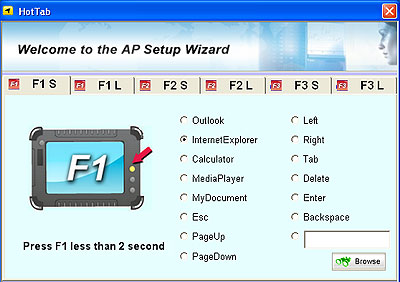 There are also three programmable function buttons labeled F1, F2 and F3. Each responds to either a short or a long push so that you can assign a total of six functions. Programming is via the HotTab utility shown to the right. You can either select from the default functions and applications and assign them to the keys, or browse for any other function or application. For example, we assigned the onscreen keyboard to F1, the calculator to F2, and My Documents to F3. There are also three programmable function buttons labeled F1, F2 and F3. Each responds to either a short or a long push so that you can assign a total of six functions. Programming is via the HotTab utility shown to the right. You can either select from the default functions and applications and assign them to the keys, or browse for any other function or application. For example, we assigned the onscreen keyboard to F1, the calculator to F2, and My Documents to F3.
A small indicator light plate below the power button on the left side of the display shows power, battery status (green for fully charged, red blinking for low battery, and orange for being charged), hard disk activity and WiFi.
Optionally available are a handstrap mounted to the back of the machine via four screws; a carry handle; a carry belt; a desktop dock/stand with battery charger; and a car power adapter.
Unlike some of the competition that uses various methods to seal plugs, Winmate uses just one. All interface blocks have protective rubber plugs that are attached to the unit via rubber hinges. The plugs must be pushed firmly into place in order to provide an effective friction seal. The unit has the following ports:
- Lower left: power and two USB
- Upper left: RJ45 LAN, microphone, headphone
- Lower right: USB and 9-pin RS232 serial
- Upper right: VGA video
- Top: PC Card Type II/III
- Bottom: Docking connector
A look inside
The inside of a rugged system often tells as much, or more, than the outside of its suitability for use in demanding applications. In the past we've seen machines that looked great outside but decidedly unfinished inside. As a result, we take a peek inside the computers we test, just to examine the engineers' design work and how well things are manufactured and finished.
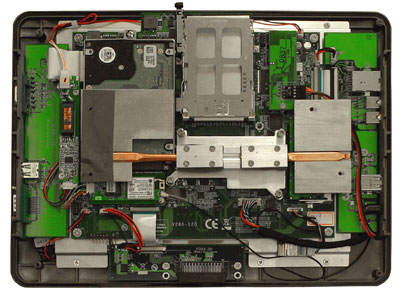 When you look inside the V280 you see a very flexible, modular configuration with a central motherboard and separate peripheral and interface blocks around it. All ports, including the docking connector, are mounted on separate boards that connect to the motherboard via short ribbon cables. This means that Winmate can probably quickly respond to specific customer configuration requirements by replacing the default interface modules with customer-specified modules. When you look inside the V280 you see a very flexible, modular configuration with a central motherboard and separate peripheral and interface blocks around it. All ports, including the docking connector, are mounted on separate boards that connect to the motherboard via short ribbon cables. This means that Winmate can probably quickly respond to specific customer configuration requirements by replacing the default interface modules with customer-specified modules.
The connectors themselves are standard issue and not sealed further against liquids or dust. This makes the rubber plugs on the outside of the computer the primary, and sole, protection against anything invading the inside of the machine. I always feel better when I see sealed connectors and a sealed connector plate.
Memory seems to be in a single SODIMM slot mounted on the motherboard. Our machine came with a 512MB module, which is generally plenty enough for an XP Embedded system. Exchange or replacement of memory modules requires opening the unit and temporarily removing part of the heat sink. No big deal.
The 2.5-inch hard disk plugs directly into a socket on the motherboard. There is a shock-absorption pad between the disk and the board, but for best shock protection and isolation we'd like to see the disk have its own separate shock-mount case.
WiFi is provided by an internal 802.11g USB module made by Taiwanese wireless specialist QCOM. The module is backwards compatible with 802.11b and connects to the system via a USB 2.0 interface.
The VIA processor and its chipset are centrally located and cooled by an elaborately machined heat sink (not final yet in our test machine). No fan is needed and so the V280 operates silently. It also barely heats up. One design issue with this approach is that the heat sink is screwed onto the backside of the computer, which means that the holes need to be aligned very precisely so the screws will grab when the computer is being put back together.
Operating System
The key to understanding a machine like the Winmate V280 and what it can offer is in understanding the difference between a general purpose operating system and an embedded operating system.
A general purpose OS, like Windows XP Professional or Windows Vista, is just that, general purpose. You can do anything you want with it, and run anything you want on it. With that in mind, Microsoft equipped Windows XP and Vista with all the drivers and software and utilities anyone could possibly need. The result is very large operating systems with numerous processes and services running all the time, all consuming memory and power. That's why you need a fast and powerful processor and lots of memory to run those machines.
An embedded operating system is completely different. The concept behind an embedded OS is to only use what the system actually needs to perform a certain task and nothing more. This dramatically reduces the space and resource requirements of the operating system, which means it can do its job without a hot-running, battery-draining processor and tons of memory. XP Embedded is therefore ideal for commercial and industrial devices that do not need all of a full-featured consumer or business OS, yet can still run thousands of existing Windows applications. An embedded OS can be as small as 40MB and it's even possible to cut it all down to around 8MB with a bootable kernel.
Unlike Vista or XP Professional, XP Embedded is not one-size-fits all. A company will determine what a machine is for and what it should be able to do. They then include as many components (hence the term "componentized" operating system) as they need. There are over 10,000 available and it's easy to create lean, nimble embedded OS platforms that can still do sophisticated high level tasks like advanced multimedia, browsing, communications or whatever a task requires. An embedded OS can even run as a real-time OS via third party plug-ins. Essentially you get the power of the basic Windows XP engine, but without any overhead you don't need.
Which means that in an embedded systems machine, benchmarks do not necessarily tell the true story. Benchmarks simply measure raw power, but not how efficiently that power is put to use. What this means is that the Winmate V280 is much quicker than you'd think it is based on its hardware specs. In fact, it runs so fast that it is hard to believe it runs on a very low power processor like the 1.2GHz VIA C7-M and just 512MB of RAM.
How fast is it?
"Speed" is relative in computers. Operating systems, systems configurations and the number of processes and utilities running in the background can have a greater impact on perceived performance than processors. A fully loaded Windows Vista computer, for example, can feel slow to users even when it runs on very fast processors. Conversely, an optimized machine with an embedded operating system can feel very quick even on minimal hardware. We installed Passmark Software's PerformanceTest 6.1 on the V280 to objectively measure performance. Passmark's benchmark suite runs about 30 tests covering CPU, 2D graphics, 3D graphics, memory, and disk and then computes scores for each category and an overall PassMark score. For comparison, we're also showing the benchmark numbers of similar machines that are based on different processor and chipset architectures. The results were as follows:
|
RELATIVE PERFORMANCE
|
Winmate V280
|
GETAC E100
|
RMT Duros
|
|
CPU
|
VIA C7M 1.2GHz
|
Intel A110 800MHz
|
Intel M 373 1.0GHz
|
|
Thermal Design Power
|
5 watts
|
3 watts
|
5 watts
|
|
CPU Mark
|
137.3
|
207.2
|
249.5
|
|
2D Graphics Mark
|
174.0
|
119.8
|
169.1
|
|
Memory Mark
|
124.1
|
155.5
|
189.6
|
|
Disk Mark
|
305.1
|
200.2
|
189.6
|
|
3D Graphics Mark
|
38.8
|
63.1
|
54.5
|
|
Overall PassMark
|
149.4
|
148.3
|
169.7
|
You can see, the VIA-powered V280's benchmark performance is in line with that of some of its competition. The machine scored especially well in 2D graphics, and the Disk Mark test results were superb suggesting that Winmate did an excellent job integrating the V280's 5400 rpm Hitachi PATA disk. Overall, the V280 feels very quick, with the snappiness we've come to expect from well-executed Windows XP Embedded systems. Should more power be needed, Winmate can also ship the V280 with a 1.6GHz version of the same processor. And if that does not fit the bill, Winmate can also deliver versions with a 1.0GHz Intel Celeron M, a 1.06GHz Intel Core 2 Duo, or even one based on either the Intel Atom Z530 processor or the popular 1.6GHz Intel Atom N270 processor and its accompanying 945GSE chipset.
Touch screen and Touchkit utility
Our V280 came with a resistive touch screen that can be operated either with a plastic stylus or with a finger. The resistive touch panel controller communicates with the processor via a serial connection and is very fast. There is a special Touchkit control panel that allows adjustment and optimization for accurate touch performance and ease of use. The panel is quite elaborate:
 - Edge Compensation is important for precise calibration. With touch screens and digitizers it can be difficult to touch or select items at the edge of the panel, especially when the display runs all the way to the kind of thick protective bezel most rugged slates have. The V280 touch panel allows you to precisely define edge compensation for all four sides, i.e., set it so the cursor thinks the edge is either farther away or closer in. Precise configuration can make for optimal usability and responsiveness in touch applications.
- Hardware causes the system to read touch screen hardware parameters. After it's done, you may, if needed, change sensitivity and delay time.
- Setting lets you set calibration linearization to either nine or 25 points, with 25 points offering maximum accuracy. You can also set double click time and area, beeps, auto right click, cursor stabilization, and five different mouse modes (like click on touch, click on release and so on) according to personal preference. I find it particularly helpful to be able to set the panel so a right mouseclick works like with an active digitizer: tap and hold. A small mouse icon always shows whether the left or right mousebutton is currently selected. If you intend to use the computer primarily with finger touch, you can set it so that the driver stops reporting data when movement is within a small, pre-defined range. This way the cursor will not jitter around when the same point is touched again or when you move a stylus within a small area.
- Display lets you map the touch screen in various ways. You can enable multiple displays and you can also map the touch screen to only part of the display. There may be custom applications where you only want to have the bottom part respond to touch, and the V280 lets you do that. You can even limit touch to a defined area anywhere on the display. This, again, may come in handy for custom applications.
The picture below shows the settings, tools and edge compensation panels. Click on it for a full size version.
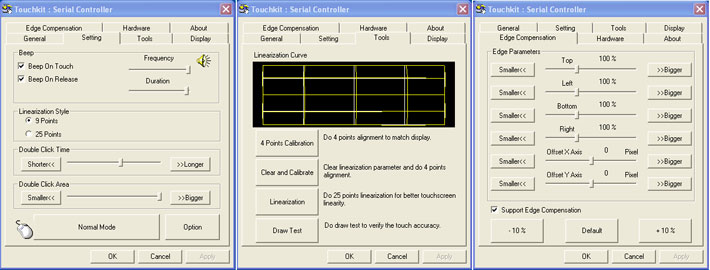
Power
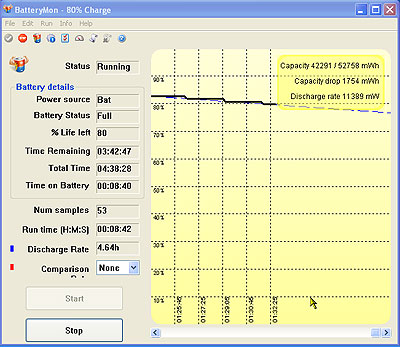 The Winmate V280 is powered by an 11.1 Volt/4,800 mAH (53 watt-hour) Lithium-Ion battery that is part of the design and fits flush into the backside of the housing. It is held in place by four big Philips screws, which means that this battery will never accidentally come loose. The connector contact block at the bottom of the battery has an O-ring rubber pressure seal that pushes against the inside of the battery compartment floor and thus creates a watertight seal. Do make sure the battery is very firmly secured as there is no further protection against water. The Winmate V280 is powered by an 11.1 Volt/4,800 mAH (53 watt-hour) Lithium-Ion battery that is part of the design and fits flush into the backside of the housing. It is held in place by four big Philips screws, which means that this battery will never accidentally come loose. The connector contact block at the bottom of the battery has an O-ring rubber pressure seal that pushes against the inside of the battery compartment floor and thus creates a watertight seal. Do make sure the battery is very firmly secured as there is no further protection against water.
We used BatteryMon to measure power consumption. The discharge rate with wireless off and the backlight set at 50% is about 11 watts. With WiFi on it is about 12 watts, and with both WiFi and Bluetooth on about 12.5 watts. The estimated battery life is therefore between 4.3 and 4.8 hours. Real world battery life, of course, varies and is based on how the machine is used.
Winmate also includes battery calibration in the slate's BIOS. The calibration utility can be accessed via the Advanced BIOS options.
Wireless and expansion
Integrated wireless communication is standard in almost all current computers, and the Winmate V280 is no different. It comes with an internal QCOM 802.11g USB module. The WiFi module can either be controlled by the standard Windows Zero Configuration utility or via a substantially more comprehensive and well-documented configuration utility from Ralink, RaConfig.
RaConfig is a tool for advanced users who want to have precise control over their wireless setup. The statistics section of RaConfig can be used to detect network problems. A special WMM panel controls wireless multimedia. Another one handles WPS (Wi-Fi Protected Setup) configurations.
If you want to stay with the standard Microsoft setup, RaConfig can still provide a variety of monitoring functions without interfering with the Windows Zero configuration or profiles.
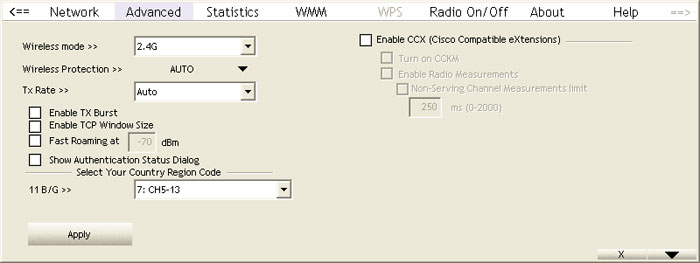
Bluetooth Version 2.0 with EDR (Enhanced Data Rate) is optionally available as an internal USB module, as is optional PC Card-based GSM/GPRS/EDGE CDMA/UMTS and GPS. Our review unit did not have the WAN function and so we could not test it. Whatever options you specify will be supported with the required internal antennas.
In terms of expansion cards, the unit has a single PC Card slot that is externally accessible and can handle either Type II or Type III cards.
Ruggedness
Winmate, as a company, has what one might call a holistic approach to rugged computing. In an overview page on their website they explain what ruggedness means to them, and what standards their rugged and semi-rugged devices must fulfill. They also explain things in simple language as opposed to the often confusing tech specs found in product literature.
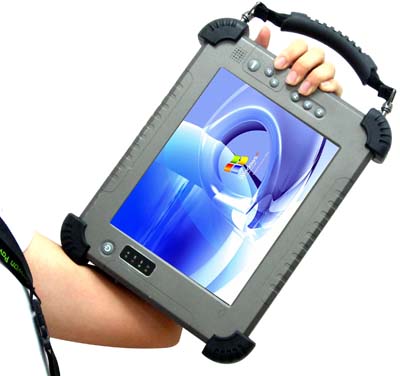 It's really all common sense. For example, "drop" means an operator drops a computer while holding it in the crook of his arm while collecting data. Shock means the often unpredictable forces a computer is subjected to when mounted in a vehicle, or when the vehicle is in an accident or collision. Vibration means the low level vibration from a motor when a computer is mounted in a vehicle, plus the impact of bumps, pot holes and so on. Temperature range means that a computer left in a car in the sun must start when the operator returns. It also must be able to handle whatever an operator might encounter on the job. Spills and dust means the machine must be reasonably protected against dust, rain or spills in typical working situations. It's really all common sense. For example, "drop" means an operator drops a computer while holding it in the crook of his arm while collecting data. Shock means the often unpredictable forces a computer is subjected to when mounted in a vehicle, or when the vehicle is in an accident or collision. Vibration means the low level vibration from a motor when a computer is mounted in a vehicle, plus the impact of bumps, pot holes and so on. Temperature range means that a computer left in a car in the sun must start when the operator returns. It also must be able to handle whatever an operator might encounter on the job. Spills and dust means the machine must be reasonably protected against dust, rain or spills in typical working situations.
Winmate also has a matrix that shows the types of testing different types of rugged and semi-rugged equipment must pass. In this matrix, "fully rugged" equipment must be sealed to an IP65 level; shock, drop and and vibration is tested according to the procedures and levels specified in MIL-STD-810F; operating temperature must be -4 to 140 degrees Fahrenheit; and housings must be aluminum-magnesium alloy.
Our test machine is marked as a fully rugged machine. The spec sheet lists shock and vibration testing according to MIL-STD-810F 514.5 and a 3-foot drop spec, but qualifies that as only pertaining to SD or industrial Compact Flash equipped units. Further, sealing is listed as just IP54 for the whole unit, with the front and sides able of handling IP65. Things are a little confusing here and Winmate should be more precise in stating what, exactly, the machine can handle. As is, we are not sure what specs apply to a hard disk equipped machine. Likewise, weight is listed as 4.9 pounds "without accessories" whereas our machine weighed 6.25 pounds.
Note that Winmate commissions 3rd party testing for shock and vibration, and is able to perform MIL-STD-810F thermal and drop testing inhouse in their own qualified TAF lab.
Different models
Winmate prides itself in making available a variety of versions and models in a certain product category. The Rugged Tablet PC V280, for example, is available both in an R10 (10-inch screen) and an R12 (12-inch screen) version. Each model is available either with the 1.2GHz version of the VIA C7-M processor or the 1.6MHz version. Both 10.4 and 12.1-inch models are available with SVGA (800 x 600 pixel) resolution displays, or with XGA (1024 x 768 pixel) resolution. Some models are also available with extra bright backlights.
Bottom line
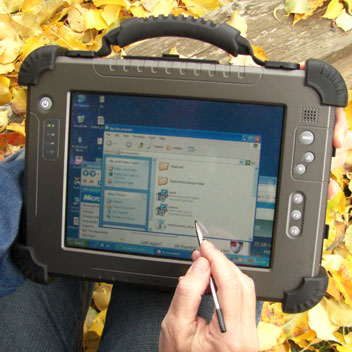 In summary, the Winmate Rugged Tablet PC V280 is a promising, highly configurable new slate computer platform from an ambitious Taiwanese display technology and industrial systems company. The machine is designed to accommodate both the 10.4-inch display that came with our review machine as well as larger 12.1-inch screens. Our test V280 weighed just over six pounds. For processing power, Winmate chose the very energy-efficient VIA C7-M CPU that's available both with 1.2GHz and 1.6GHz clock speeds. No fan is required, and the unit barely heats up. The aluminum-magnesium alloy case is extremely solid and well executed, and there is extra protection in the form of large rubber bumpers. The V280 is sealed to IP54 specifications.
In summary, the Winmate Rugged Tablet PC V280 is a promising, highly configurable new slate computer platform from an ambitious Taiwanese display technology and industrial systems company. The machine is designed to accommodate both the 10.4-inch display that came with our review machine as well as larger 12.1-inch screens. Our test V280 weighed just over six pounds. For processing power, Winmate chose the very energy-efficient VIA C7-M CPU that's available both with 1.2GHz and 1.6GHz clock speeds. No fan is required, and the unit barely heats up. The aluminum-magnesium alloy case is extremely solid and well executed, and there is extra protection in the form of large rubber bumpers. The V280 is sealed to IP54 specifications.
One of the benefits of the relatively large case is that customers can specify either a 10.4 or a 12.1-inch display in a class of computers often limited to 8.4-inch screens. While our tester had a SVGA (800 x 600 pixel) display, Winmate also offers 1024 x 768 pixel resolution and sunlight-readable display technology. The display on our machine was well readable outdoors. The touch screen is very responsive and highly configurable. An electromagetic digitizer is not available.
While heavily sealed units often lack a lot of connectivity, that's not the case with the V280. You get three USB 2.0 ports, gigabit LAN, RS232 serial, video, audio in and out, and a docking connector. There is also a PC Card Type II/III slot that can be used for expansion or for GPS or wide area wireless radio communication options. All ports are sealed with attached protective rubber plugs.
Our review unit came with Windows XP Embedded, which can be run either off a hard disk, a solid state disk, or industrial CF Card flash. Our review machine was quick even with the low-power processor and just 512MB of RAM. The V280 is a rugged machine, but always make sure that all protective plugs are very firmly in place.
While facing well-established competition in the industrial tablet market, the Winmate V280 offers a clean and highly expandable and configurable rugged tablet computing platform that is well suited for a wide variety of challenging jobs in field service, law enforcement, fire/emergency, transportation & distribution, construction, utility and energy, warehousing, patient information, and retail. This platform is certainly an opportunity for OEM/ODM relationships and rebranding partners.
-- Conrad H. Blickenstorfer
Winmate Rugged Tablet PC V280 Specs:
| Type |
Rugged pen tablet
|
| Processor |
1.2GHz VIA C7M Nano (Intel Celeron M, Core 2 Duo and Atom Z2x0 and Z5x0 also available) |
| Display Chipset |
VIA VX700 |
| OS |
Windows XP Professional or Windows XP Embedded
|
| Memory |
512MB or 1024MB DDR2 400MHz via one SODIMM slot |
| Display |
10.4" SVGA (800 x 600) TFT with 220 nits backlight; optional sunlight-viewable TFT (540 nits); 1024 x 768 versions also available |
| Digitizer |
4-wire resistive touch screen |
| Keyboard |
Optional external USB keyboard |
| Storage |
Hitachi 5400 rpm PATA 80GB 2.5-inch hard disk or SSD
|
| Expansion slots |
1 PC Card Type II/III
|
| Housing |
Aluminum-magnesium alloy with protective rubber bumpers |
| Size |
12.25 x 9.1 x 1.75 |
| Weight |
6.25 lbs. as tested (with battery, bumpers and handle)
|
| Operating temperature |
-4 to 140 degrees Fahrenheit |
| Ingress protection |
IP54 whole unit, IP65 front |
| Drop |
3 feet to concrete (with SSD or CF Flash) |
| Vibration |
MIL-STD-810F 514.5 (with SSD or CF Flash) |
| Power |
Rechargeable Li-Ion, 11.1V, 4,800mAH 53.3 WHr |
| Interface |
3 USB 2.0, RJ45 (gigabit), audio in/out, video, docking (4 USB, RS232) |
| Wireless options |
802.11b/g, Bluetooth; optional PC Card-based GSM/GPRS/EDGE CDMA/UMTS and GPS
|
| Price |
depends on configuration (sample starting around US$2,000) |
| Contact |
winmate.com.tw
Sales1@winmate.com.tw |
(copyright 2009 RuggedPCReview.com)
|





